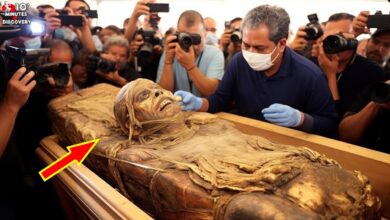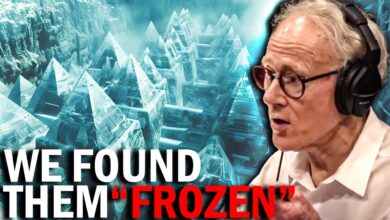Archaeologists Discovered Non-Human DNA Inside An Ancient Cave And It’s Not What You Think

Dennisova Cave, located deep in the Altai Mountains of Siberia, has become one of the most significant sites in the study of human evolution. Discovered in 1977 by Russian scientists, it initially seemed like a typical archaeological site in a region known for its historical richness. However, in 2008, the excavation unearthed a fragment of a pinky bone, dating back over 40,000 years, which dramatically changed our understanding of human history. This small piece of bone led to the identification of a completely new species of ancient humans, the Denisovans, who lived alongside Neanderthals and anatomically modern humans.
The discovery of the Denisovans was groundbreaking for several reasons. First, the DNA from the pinky bone fragment revealed that these humans were neither Neanderthals nor modern humans but represented a distinct branch of humanity. They were more closely related to Neanderthals than to modern humans, yet they exhibited a unique lineage, one that had previously slipped through time unnoticed. This revelation reshaped our understanding of the human family tree, showing that there were more branches of early human evolution than previously thought.
Denisovans were not primitive or subhuman, as was once thought about early human species. Evidence shows that they were capable of complex behaviors. For instance, they crafted advanced tools, and their cave also contained polished ornaments, including bracelets made from greenstone and pendants made from mammoth ivory. These objects were far more sophisticated than previously assumed for such early humans, suggesting they had cultural practices and craftsmanship that rivaled that of early Homo sapiens. This challenges the view that only Homo sapiens were capable of symbolic thought and advanced tools.
The Denisovans’ DNA has been found not only in the remains within the cave but also in the genetic makeup of modern populations in distant regions, such as Southeast Asia, Australia, and even the Philippines. This indicates that the Denisovans once had a wide geographic range, far beyond the confines of Siberia. Their genetic legacy lives on in people today, particularly in populations like Melanesians and Aboriginal Australians, who carry Denisovan DNA linked to traits such as high-altitude adaptation and immune system responses. For instance, in Tibet, Denisovan genes help people thrive in the thin, oxygen-poor air at high altitudes, a trait that likely helped Denisovans survive in their harsh environment.
One of the most fascinating aspects of the Denisovan discovery is the potential for their technological and cultural contributions. Archaeologists have found tools that are both simple and advanced, suggesting that the Denisovans had a varied but sophisticated understanding of their surroundings. Their advanced jewelry, especially delicate bracelets carved with such precision, raises questions about their level of technological prowess. One of the bracelets was drilled so precisely that it suggested the use of a drill or tool that was beyond what was thought possible for their time. Could this be a sign of lost technology or even ancient knowledge that has since been forgotten? Some theorists propose that the Denisovans might have had an understanding of the stars or even the ability to navigate the oceans, making them early explorers who crossed vast distances, a possibility supported by the wide spread of their genetic material.
Additionally, some scientists believe that the Denisovans may have had larger brains or unique cognitive abilities that gave them an advantage over other species. Their ability to create such detailed and advanced artifacts points to a level of intelligence and creativity that many people did not initially associate with early human species. The evidence of complex tool-making, along with their advanced knowledge of materials, paints a picture of a species far more sophisticated than their physical remains suggest.
Another intriguing aspect of the Denisovan discovery is its connection to ancient myths and folklore. In Siberia and surrounding regions, there are legends of giants and advanced civilizations that vanished without a trace. Could these stories be based on real encounters with Denisovans or other ancient human species? The mystery of the Denisovans blurs the line between myth and reality, creating a sense that there is still much to uncover about the interactions between different branches of early humans. Could ancient memories of these “giants” be based on the presence of Denisovans, whose physical size and abilities may have been exaggerated over time into legends?
The Denisovans, while a lost branch of humanity, may have played a crucial role in shaping the evolutionary story of humans. The discovery of Denisovan genes in modern populations shows that these ancient humans interacted with other species, including Neanderthals and early Homo sapiens, suggesting that these different human species may have interbred and shared cultural practices, knowledge, and technologies. Their DNA lives on, hidden in our genomes, influencing aspects of our biology that we are only now beginning to understand.
As more remains are discovered, including teeth, skull fragments, and more advanced tools, scientists are piecing together a clearer picture of Denisovans’ lives. Some of the bones, such as molars, show that they were physically distinct from Neanderthals and early Homo sapiens. These remains were found alongside advanced artifacts, raising questions about how such primitive physical traits could coexist with such complex behavior.
The Denisovans were likely not isolated but part of a broader network of human species that interacted with one another, exchanging ideas, tools, and knowledge. The Denisova Cave may have been a meeting place, a crossroads where different branches of humanity converged, shared their knowledge, and then disappeared into history. The discovery of their presence has opened up the possibility that many other branches of humanity could still be hidden in ancient caves and forgotten places.
In conclusion, the Denisovan discovery is not just about a forgotten human species; it’s about rewriting our understanding of human evolution. The Denisovans challenge everything we thought we knew about early humans and their capabilities, and they might even reshape our conception of who we are today. The secrets buried in Denisova Cave could hold the answers to questions about our past, offering a glimpse into a time when different species of humans coexisted, explored, and possibly shaped the future of civilization in ways we are only beginning to understand.








